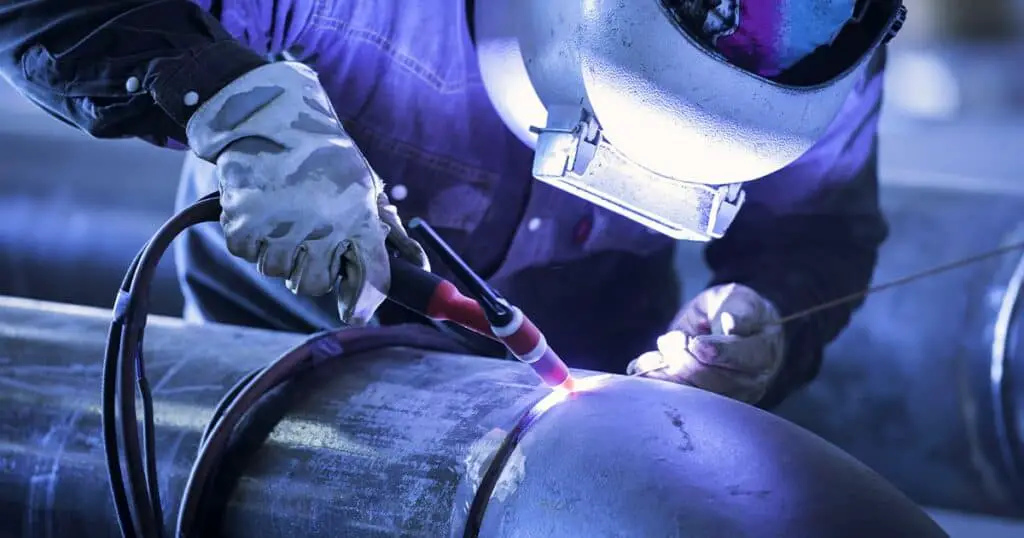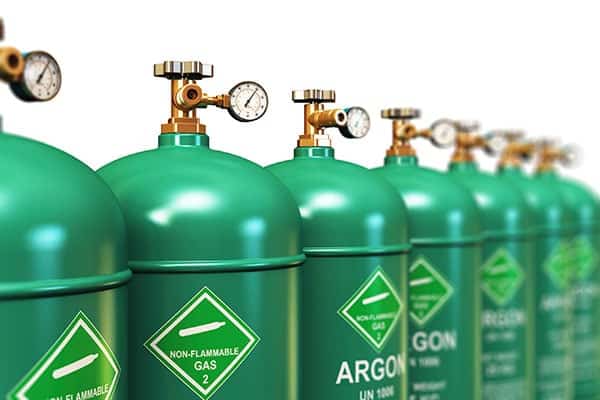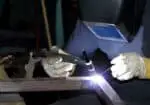TIG or tungsten inert gas welding is one of the most popular ways to weld metals in a seamless way. It uses the same principle as arc welding does, the difference being that TIG welding uses a non-consumable electrode.
The non-consumable electrode contributes to most of the advantages of tig welding. Not only does tig welding is used to weld all sorts of metals, but it also offers very clean joints.
There are, however, some disadvantages of tig welding, per se, tig welding is an exhausting time-consuming job. It requires some exceptional skills to carry out this sort of welding.
Since tig welding is quite popular, it’s obvious that there’s a lot of curiosity about tig welding. People want to know the advantages and disadvantages of tig welding, what kind of inert gas can be used for this sort of welding, whether or not it’s easy to learn how to use and operate a tig machine for welding, and much more.
If you’ve been wondering the same and have similar questions cluttering your mind, then Sirs’ and Madams’, you’ve just hit a jackpot with this post. It will brief you up on the advantages and disadvantages of tig welding.
Dive in!
What is TIG Welding?
TIG welding is a form of welding where a non-consumable electrode is patched to the negative terminal and the metal surface that’s supposed to be welded is patched to the positive terminal.
Once started, a very high electric point is achieved and that heat is used to weld the metal. The purpose of inert gas is to prevent oxidation by hampering oxygen to come in direct contact with the surface that’s being welded.
What Gases are Used for TIG Welding?
Inert gas has a very significant role in TIG welding. Mostly, argon is the first choice of gas that’s used. However, there are some other options too that include:
→ Helium is the next best option after Argon.
→ Sometimes, a mixture of Argon and Helium is also used.
Why is Argon Gas Used in TIG Welding?
Argon offers certain benefits that make it the number one choice for inert gas in TIG welding.
Let’s explore a couple of reasons that Argon is the most preferred gas in the pointers summarized below.
1.) To begin with, Argon is a non-inflammable gas. Hence, it’s very safe.
2.) Argon is least reactive to Oxygen. Since oxygen is the reason behind the oxidation of metal being welded, a gas that has very little content of oxygen is naturally going to be the best choice.
Sometimes, you might find that nitrogen and hydrogen are added to Argon in very minuscule amounts.
If it’s a stainless steel surface or aluminum surface that is being welded, pure Argon is the best option. In the cases of other metals, additional gases (as mentioned above) are used for the purpose of stabilizing the electric arc.
What are the Advantages of TIG Welding?
TIG offers some stunning advantages over MIG welding that make it an effective and result-oriented welding method. Let’s find out some advantages of TIG welding in the sections to follow.
#1 TIG welding offers precision like nothing else
Using the TIG method has lately gained popularity because it gives a seamless finish. The outcome is neat and the joint looks precise and the work of sheer art.
A couple of reasons that TIG is able to offer such crisp joints include the following.
1.) You can control the heat you want. That’s because TIG has a pedal that you can operate in order to achieve the amount of heat you require.
2.) Once the desired temperature is achieved, the arc doesn’t stop because the tungsten electrode doesn’t exhaust. It gives continuity (no lag whatsoever) that reflects in the final outcome.
#2 TIG works in all directions
Yes, you heard us just fine: there’s no limitation to the direction of welding. You can weld vertically, horizontally, upside-down, sides, and whatnot.
No matter how awkward the position is, just point the torch in the direction you want and TIG will work like a dream.
#3 TIG welding doesn’t mind the thickness
If the metal you want to weld is very thin, TIG welding is your way out to make clean cuts and joints. The outcome is so smooth that even finishing might not be needed.
#4 TIG guarantees versatility and Variety
TIG is a versatile form of welding since there’s absolutely no metal that it cannot weld. It can be used to weld every metal surface ranging from stainless steel to aluminum, copper, magnesium, brass, titanium, gold, nickel, and even the alloys of these metals with no problem whatsoever.
The variety in terms of applications is quite diverse too. Since there’s no requirement of flux and the fact that the tungsten electrode doesn’t melt even when the temperature gets as high as 3400°C, TIG can be used in industries like:
-
-
- Aerospace industry
- Building and construction industry
- Automobiles industry
- Food manufacturing industry
-
The bottom line is TIG can be used everywhere where there’s a requirement of ultimate precision and finish.
#5 Tig Reduces Some Welding Hazards
Did you know that TIG is a form of welding that does not produce sparks when you start welding metals?
Also, when the machine is clear and doesn’t have contaminants, fumes won’t be produced either.
Top Five Disadvantages of TIG Welding
With the kinds of advantages and versatility that TIG welding offers, it might give you an impression that it doesn’t have disadvantages. But that’s not true.
TIG welding comes with its own set of flaws and disadvantages. The most noteworthy disadvantages of TIG welding have been discussed in the upcoming sections.
#1 Tig welding is very difficult
If you thought you could just wake up tomorrow and start using the TIG machine for welding, you’re up for a very rude surprise: operating a TIG welding machine is tough. It takes special handling and years of experience to actually control this form of welding.
Even welders with years of experience slowly transition towards TIG welding. If you’ve just begun, you’ll have to take special classes and courses to learn how to weld using this technique.
#2 Controlling the pedal isn’t easy
The pedal control is a boon only for experienced welders. For welders who aren’t experienced, handling the heat using the pedal is very tough.
If you accidentally press the pedal quickly with a jerk, small welding craters will be left on the metal’s surface in no time.
So, yes, it’s not a cakewalk to weld using the TIG method.
#3 Tig welding will test your patience
Why do we say so despite the fact that you might be qualified and trained to use TIG for welding? Well, that’s because TIG welding is very time-consuming. For the kind of precision it’s known for, it requires a lot of time.
Aside from the slow welding rate, there are some other factors that you’ll find very testy. Here’s a glimpse:
1.) The TIG machine requires meticulous cleaning. There’s no room for errors since any contaminant will corrode the surface being welded.
2.) The cost of welding will be higher too.
#4 TIG won’t work in dramatic windy weather
When working outdoors where there’s a thunderstorm accompanied by very high wind speed, the gas will blow away. So, working with a TIG machine in a storm can be extremely tough. It will compromise the quality and add to the frustration.
#5 Overheating is a threat with TIG
This is another issue with TIG welding. There’s no room for error. As you already know by now that you can control the temperature using a pedal, even a slight bit of distraction or operational error can lead to overheating.
Once overheated, the surface of the metal will discolor in no time, leaving the joint brittle and susceptible to breaking.
As long as you haven’t developed the pulsing capability, you won’t be able to reduce the amperage smoothly. And the result, every time, will be overheating.
Advantages of TIG Welding Over MIG Welding
If you carefully go through all the afore mentioned disadvantages, you’ll realize that all that’s required to overcome them is proper training.
Once you’re properly trained to handle the TIG method, it’s a boon. Its advantages over MIG welding are worth a mention.
Here’s a sneak-peek that’ll give you an idea why TIG is more advantageous over MIG:
1.) The kind of clean joints and finishing that TIG offers cannot be achieved using MIG welding.
2.) You can control and adjust the heat using TIG welding. This freedom isn’t possible with MIG welding.
3.) TIG doesn’t produce fumes and sparks; MIG does. Naturally, TIG welding is comparatively safer than MIG welding.
4.) TIG can be used to weld and cut thin sheets of metals. MIG does not offer this variation either.
See also: Can MIG and TIG Welding be Done with the Same Machine?
Concluding Thoughts:
There are many advantages and some disadvantages of using TIG for welding. The biggest advantages of TIG include stronger and cleaner joints, the use of non-consumable tungsten electrodes, and the variety of metals it can be used on.
The biggest disadvantages of TIG welding are the result of how difficult it is to control the TIG welding machine. You have to learn how to control the pedal and master the art of pulsing to control the amperage.
Despite the disadvantages, TIG welding is absolutely worth it. All it requires is proper training that’ll help you transition from other forms of welding to tig welding.
Once you’ve mastered the art, you’ll be able to earn a lot since the payment for TIG welding is much more than any other form of welding.








